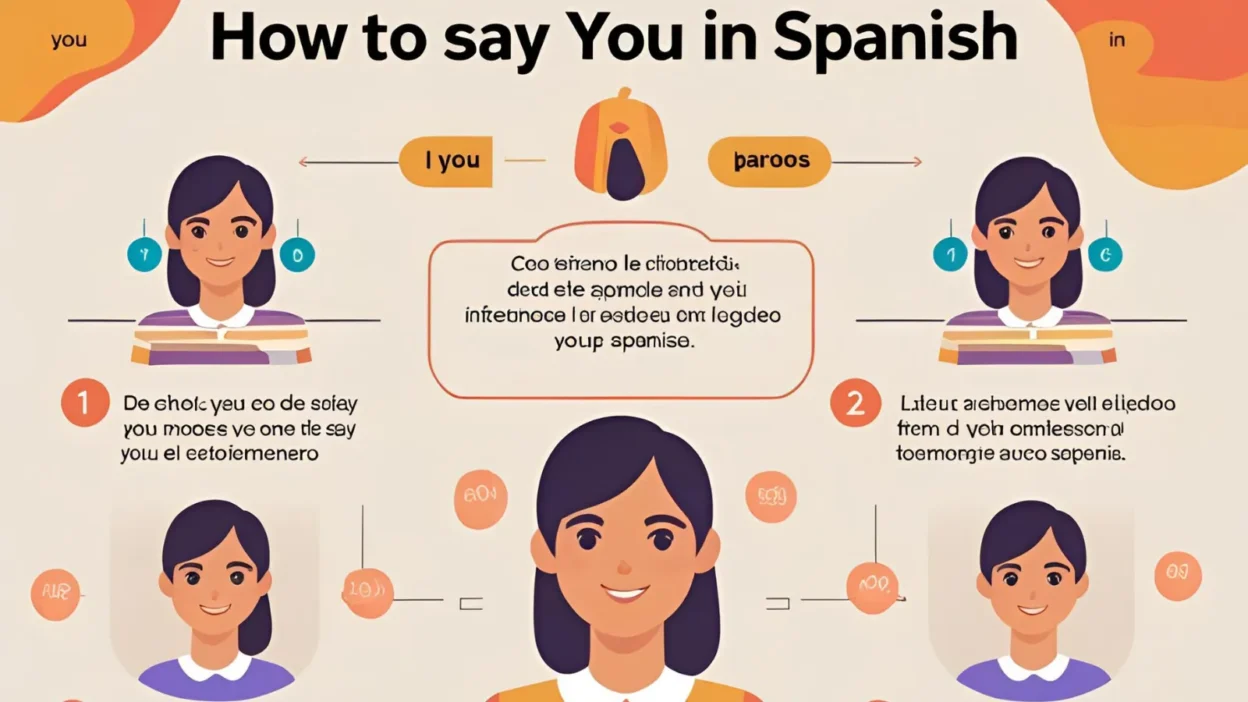Learning how to say you in Spanish is one of the most important steps for beginners. Unlike English, Spanish has different words for you depending on formality, number of people, and even the country you’re in.
For example, in Spain people often use tú and vosotros, while in Latin America you’ll hear usted or ustedes.
By understanding the right way to say you, you’ll sound more natural and respectful in different situations.
You in Spanish
Learn 15 ways to say you in Spanish with examples and cultural context.
🟢 = Standard | 🔵 = Regional | 🟣 = Formal/Polite
| # | Spanish Word/Phrase | English Meaning | Tone/Usage |
|---|---|---|---|
| 1 | Tú | You (informal, singular) | 🟢 Standard |
| 2 | Usted | You (formal, singular) | 🟣 Formal |
| 3 | Vos | You (informal, singular) | 🔵 Regional (Argentina, Uruguay, parts of LatAm) |
| 4 | Vosotros | You all (informal, plural) | 🔵 Regional (Spain only) |
| 5 | Ustedes | You all (formal in Spain, both formal/informal in Latin America) | 🟣 Formal / 🔵 Regional |
| 6 | Contigo | With you (informal) | 🟢 Standard |
| 7 | Con usted | With you (formal) | 🟣 Formal |
| 8 | Te | You (direct/indirect object, informal) | 🟢 Standard |
| 9 | Lo / La | You (direct object, formal masculine/feminine) | 🟣 Formal |
| 10 | Le | You (indirect object, formal) | 🟣 Formal |
| 11 | A ti | To you (informal emphasis) | 🟢 Standard |
| 12 | A usted | To you (formal emphasis) | 🟣 Formal |
| 13 | Entre vosotros | Among you (plural, Spain) | 🔵 Regional |
| 14 | Entre ustedes | Among you all (plural, Latin America) | 🔵 Regional |
| 15 | Vos sos… | You are… (informal, voseo) | 🔵 Regional (Argentina, Uruguay, Paraguay) |
1. Tú
Origin:
“Tú” is the most common informal singular form of “you.” It comes from Latin “tu,” and is used in friendly, casual settings.
Example:
👤 User A: ¿Tú vienes a la fiesta?
👤 User B: Sí, claro. ¡Nos vemos allí!
Use: Informal; used with friends, family, or people your age.
2. Usted

Origin:
“Usted” evolved from the phrase Vuestra Merced (“Your Grace”), and it’s the formal singular way to say “you.”
Example:
👤 User A: ¿Usted necesita ayuda?
👤 User B: Sí, muchas gracias.
Use: Formal; for elders, strangers, or in professional situations.
3. Vos
Origin:
“Vos” is used instead of “tú” in many Latin American countries, especially Argentina, Uruguay, Paraguay, and parts of Central America. It evolved from Latin “vos,” originally a plural.
Example:
👤 User A: ¿Vos sabés lo que pasó ayer?
👤 User B: ¡Sí, una locura total!
Use: Informal; regional.
4. Vosotros / Vosotras

Origin:
This is the plural form of “you” used only in Spain (except in formal situations). “Vosotras” is used when speaking to an all-female group.
Example:
👤 User A: ¿Vosotros vais al cine?
👤 User B: Sí, vamos a las ocho.
Use: Informal plural; only in Spain.
5. Ustedes
Origin:
Plural of “usted,” but used in both formal and informal contexts in Latin America. In Spain, it’s only used for formal plural.
Example:
👤 User A: ¿Ustedes necesitan algo más?
👤 User B: No, estamos bien. Gracias.
Use: Plural “you”; formal in Spain, universal in Latin America.
6. Te (object form of tú)

Origin:
“Te” is the object pronoun used when someone is doing something to “you” (tú).
Example:
👤 User A: Te quiero mucho.
👤 User B: ¡Aww, yo también!
Use: Informal; direct object of the verb.
7. Le (object form of usted)
Origin:
“Le” is the indirect object pronoun for “usted.”
Example:
👤 User A: Le traje el documento que pidió.
👤 User B: Gracias, muy amable.
Use: Formal; respectful tone.
8. Contigo
Origin:
A contraction of “con” + “tigo” (from “ti”), meaning “with you.”
Example:
👤 User A: Quiero ir contigo al concierto.
👤 User B: ¡Perfecto! Yo también quiero ir.
Use: Informal.
9. Con usted
Origin:
The formal version of “with you.”
Example:
👤 User A: Fue un honor trabajar con usted.
👤 User B: El honor fue mío.
Use: Formal.
10. Ti (after prepositions)
Origin:
Used after prepositions like para ti, de ti, a ti. It refers to informal “you.”
Example:
👤 User A: Este regalo es para ti.
👤 User B: ¡Gracias, qué lindo detalle!
Use: Informal; used after prepositions.
11. Sí (reflexive for usted)
Origin:
Used in reflexive constructions when referring formally to “you.”
Example:
👤 User A: Usted debe cuidarse bien.
👤 User B: Sí, lo haré.
Use: Formal reflexive “you.”
12. Os (object form of vosotros/vosotras)
Origin:
Used in Spain when referring to informal plural “you.”
Example:
👤 User A: Os dije que llegáramos temprano.
👤 User B: Lo sabemos, lo sentimos.
Use: Spain only; informal plural object.
13. Se (formal reflexive)
Origin:
Reflexive for “usted” or “ustedes.”
Example:
👤 User A: Se cuida mucho, por favor.
👤 User B: Gracias, lo haré.
Use: Formal; used in reflexive or passive structures.
14. Vos decís / Vosotros decís (regional grammar twist)
Origin:
In vos regions (e.g., Argentina), the verb conjugation also changes. “Decís” is used instead of “dices.”
Example:
👤 User A: ¿Vos decís que va a llover?
👤 User B: Eso creo, sí.
Use: Argentina, Uruguay, etc.; shows regional identity.
15. Usted mismo / Tú mismo (emphatic)
Origin:
Used for emphasis to say “you yourself.”
Example:
👤 User A: Tú mismo lo dijiste.
👤 User B: Tienes razón.
Use: Emphatic or reflective.
Conclusion:
Understanding how to say you in Spanish is essential because the word changes based on formality, number, and region.
If you’re speaking casually with one person, you’ll use tú or vos, but in polite situations you’ll need usted. When talking to a group, Spain uses vosotros, while most of Latin America prefers ustedes.
By learning these variations, you’ll not only improve your Spanish but also show respect and adapt naturally to different cultures.



